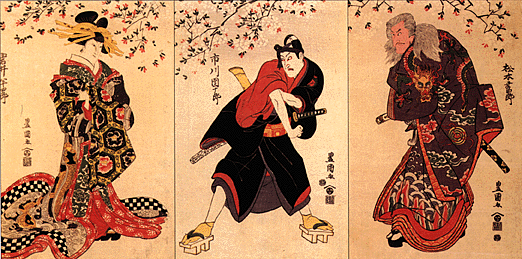 |
|
|
|
Character types in Kabuki tend to be pretty clearly (over)drawn: heroes, villains, and love interests. Variations exist within these types--and there's an occasional exception to them--but you'll find few subtleties and ambiguities. Plots, too, are not the focus of realistic development. Stories tend to be farcical in nature, serving more as a vehicle for the overall spectacle of the actors on stage. The plot of Sukeroku revolves around the hero's attempts to recover a stolen heirloom sword by picking fights with samurai in the pleasure quarters in order to see what kind of sword they draw. At the same time a love-rivalry emerges between Sukeroku and the evil old samurai Hige no Ikyû (Beared Ikyû) over the high-class courtesan Agemaki. Being the one who stole the sword, Ikyû--in perhaps one of the most popular Kabuki scenes ever--refuses to draw and instead suffers the public humiliation of submitting meekly to having one of Sukeroku's sandals placed on his head. Follow Agemaki to view other onnagata; Ikyû for examples of real costumes worn in this play. |